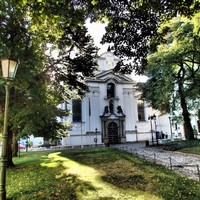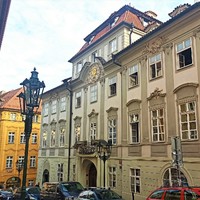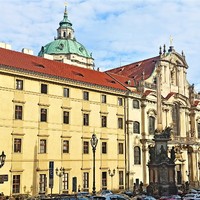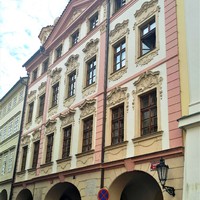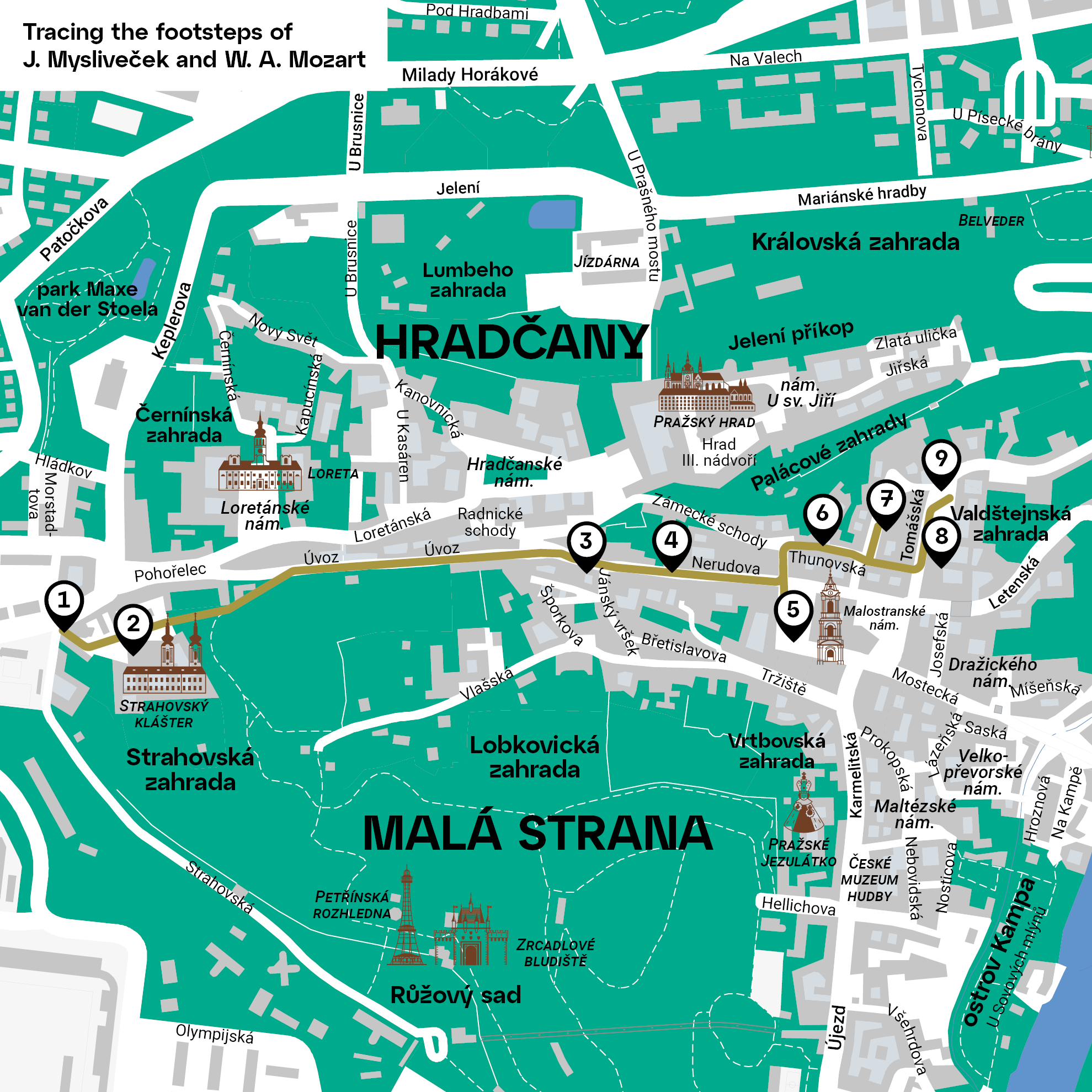Breadcrumbs navigation
Tracing the footsteps of Josef Mysliveček and Wolfgang Amadeus Mozart in Prague
Walking route: Strahov courtyard – Úvoz – Nerudova street – Malostranské square – Zámecká – Thunovská – Sněmovní – Thunovská – Tomášská – Valdštejnské square
The Prague-born composer and author of a number of opera seria pieces, Josef Mysliveček (1737-1781) left for Italy at the age of 26 and managed to establish himself on leading Italian stages. He was already a ‘superstar’ when he met young Wolfgang’s father Leopold Mozart, who saw him as a celebrity and a possible role model for his gifted son. The young Wolfgang Amadeus Mozart (1756-1791) held Mysliveček in great esteem and a deep friendship developed between them, which persisted even after Mysliveček began to suffer from illness (probably syphilis) and Leopold Mozart cooled towards him due to his alleged immoral lifestyle and the fact that he could not secure Wolfgang a commission for an opera in Naples. Indeed, a lot of information about Mysliveček’s life is known only thanks to correspondence between the Mozarts.
Although they never met up in Prague, it undoubtedly become a landmark city in the lives of both musical greats. There are many places in Prague demonstrably related to both composers. Our second Prague route tracing the footsteps of Josef Mysliveček, this time including Mozart, leads through the Lesser Town.
→ Strahov courtyard → ① Church of St Roch → ② Basilica of the Assumption of the Virgin Mary
Church of St Roch
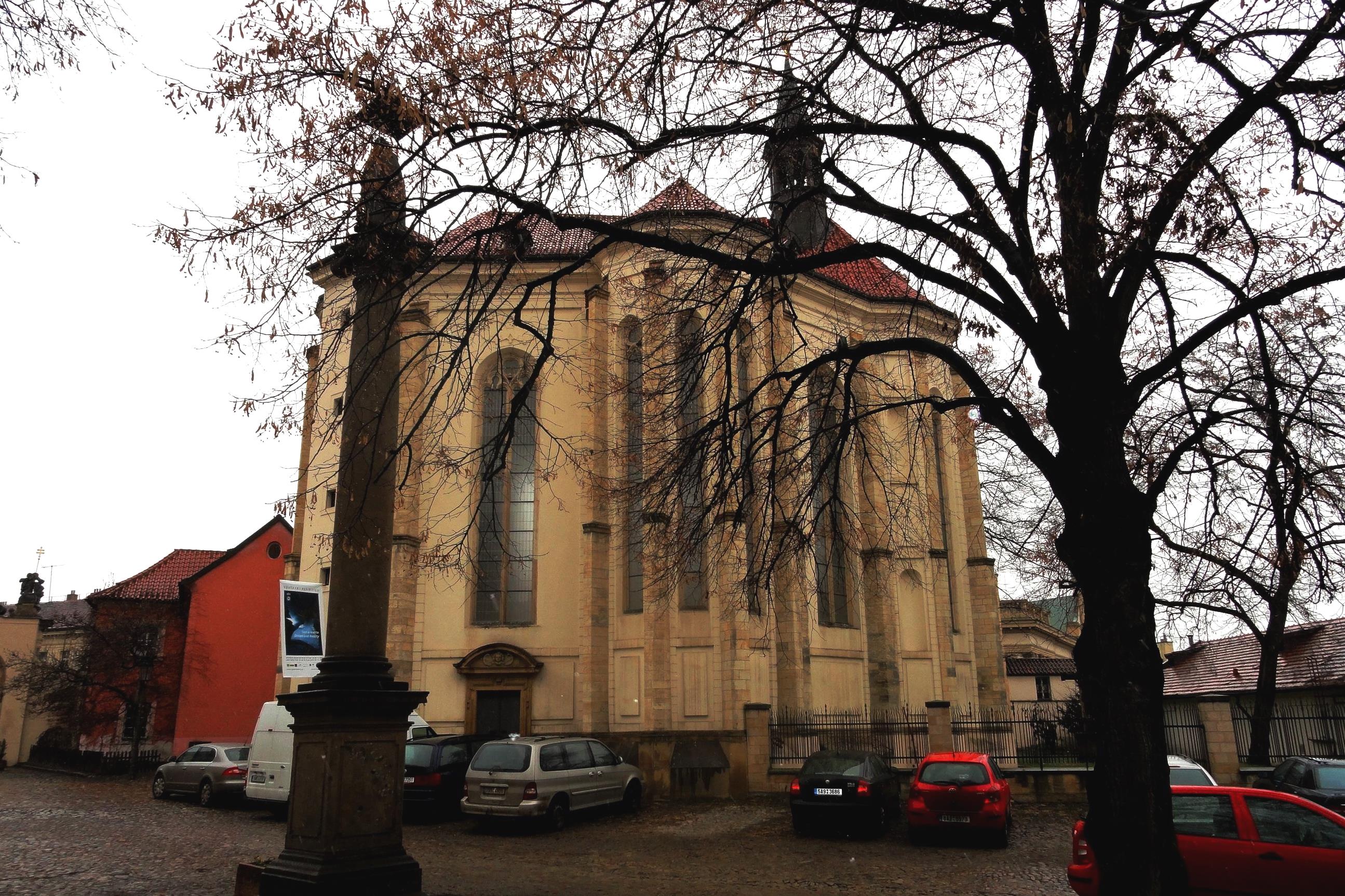 The church of St Roch is linked to the history of Josef Mysliveček’s family. His grandfather Pavel Mysliveček (1653–1703) married Josef’s grandmother, the widow Ludmila Málková (about 1657–1720), in this then parish church on 18 September 1688. Pavel and Ludmila lived in Horní Šárka, where they operated the so-called Oak mill, originally belonging to the Strahov Monastery. They did well for themselves, so in time bought the mill from the monastery. They had 10 children, the 7th of whom was the composer’s father Matěj, who was baptized in the church of St Roch in 1697. He was to inherit the family mill after the death of his parents, because his older brothers had left home earlier. Matěj kept the mill, but moved to Prague, where his residence is first documented in 1726. Only two years later he was already renting Sova’s Mills on Kampa, where the future composer Josef Mysliveček was born on 9 March 1737.
The church of St Roch is linked to the history of Josef Mysliveček’s family. His grandfather Pavel Mysliveček (1653–1703) married Josef’s grandmother, the widow Ludmila Málková (about 1657–1720), in this then parish church on 18 September 1688. Pavel and Ludmila lived in Horní Šárka, where they operated the so-called Oak mill, originally belonging to the Strahov Monastery. They did well for themselves, so in time bought the mill from the monastery. They had 10 children, the 7th of whom was the composer’s father Matěj, who was baptized in the church of St Roch in 1697. He was to inherit the family mill after the death of his parents, because his older brothers had left home earlier. Matěj kept the mill, but moved to Prague, where his residence is first documented in 1726. Only two years later he was already renting Sova’s Mills on Kampa, where the future composer Josef Mysliveček was born on 9 March 1737.
Basilica of the Assumption of the Virgin Mary
Another place in the Strahov Monastery, this time connected with Mozart, is the Basilica of the Assumption of the Virgin Mary. The Basilica, a three-nave Romanesque building at heart, got its present appearance through a Baroque adaptation. The décor of its nave by J. W. Neunherzte is breathtaking, featuring a set of frescoes with Marian motifs on the vault and scenes from the life of St Norbert on the walls. There are many places that are more or less legendarily connected with Mozart’s stays in Prague. Still, the fact that Mozart improvised on the organ in the Basilica of the Assumption of the Virgin Mary is safely documented. What’s more, one of the monks managed to write down Mozart’s improvisation. This score of Mozart’s improvisation is still kept at Strahov Monastery Library. The original organ was replaced in 1900, however.
→ Úvoz → Nerudova street → ③ Nerudova 33
From the Strahov Basilica, visit the lookout overlooking the still functioning vineyard beneath Strahov Monastery, to get one of the most beautiful vistas of Prague. Continue along the path to Úvoz street, which will take you down to Nerudova street. This local road was formerly called Strahov lane, later Hluboká [Deep or Sunken] lane. Its current name Úvoz, [Holloway], dates from 1870 and has remained since. On the right side you will pass the Great Strahov Monastery Garden, which covers an area of more than 11 hectares, and about 100 metres of elevation.
Bretfeld Palace
Follow Nerudova street down to where the stairs to Jánský vršek veer off. The corner building with a rich late Baroque façade is the Bretfeld Palace. There was a Renaissance house here, built on Gothic foundations, and owes its current look to several Baroque modifications from the 18th century. The beautiful façade, attributed to the architect J. J. Wirch, has typically palatial high-ceiling floors, which is readily apparent, particularly in the so-called piano nobile or 1st floor, the reception rooms of the palace.
Why is the palace called Bretfeldovský and what is its connection to Mysliveček or Mozart? The original townhouse ‘At Summer and Winter’ was bought in 1765 by Josef Bretfeld, a lawyer and six-times-elected rector of Prague’s Charles-Ferdinand University, who was knighted in 1793 (and in 1807 even became a Freiherr [a Baron with unfettered land title]). He turned his renovated palace into an acclaimed social centre; renowned balls and concerts were held here. Leading socialites of the time were invited to them; Mozart was also a guest. It was in this palace that he was supposedly to have met another famous character of that time, Giacomo Casanova. Whether they did actually meet remains an open question. What is certain is that after the death of Josef Bretfeld of Kronenburg (who incidentally lived to be 91, meaning he owned the Bretfeld Palace for an incredible 55 years!) his daughter Terezie sold the palace.
→ ④ Nerudova 22
The Church of Our Lady Mother of Ceaseless Help and St Cajetan
The next stop will be a few dozen metres below the opposite church, known as St Cajetan for short, which was founded together with the Theatine monastery (the Order is sometimes called the Cajetans after its founder Gaetano dei Conti di Thiene) at the turn of the 17th and 18th centuries. The original design was by friar Guarino Guarini back in 1679. It was very ambitious, and had to be adapted several times, first by Jean Baptiste Mathey. Construction began in 1703, but it was not until 8 years later that permission was issued to demolish the Black Gate, so that the church could be completed. The final modification was undertaken by ingenious builder Jan Blažej Santini Aichel.
This church was to be very significant for Josef Mysliveček, because the Czech composer and pedagogue František Václav Habermann worked here, who taught Josef musical composition. Habermann held the position of choirmaster here (he was also the ‘regenschori’ in the Church of Our Lady beneath the Chain in the Lesser Town); at the same time, he was a well-known tutor and taught music at influential noble families; also among his pupils was František Xaver Dušek. Habermann travelled extensively in his youth and gained experience as a musician in Italy, France and Spain. He was a master of counterpoint, and he also had experience in composing theatrical music. However, Mysliveček reportedly found the pace of his teaching too slow and turned to another choirmaster, Josef Seger. Incidentally, G. F. Händel also much appreciated Habermann’s work.
→ Nerudova → ⑤ Lesser Town square
Church of St Nicholas
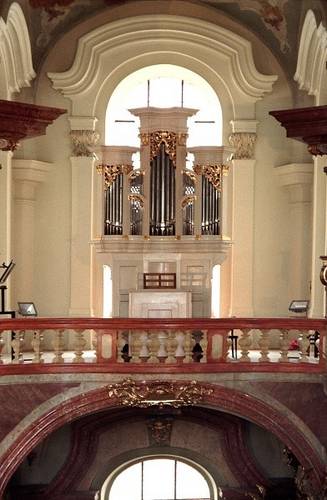 Let’s walk along Nerudova street to the Lesser Town Square with its impressive Church of St Nicholas. This most famous of Prague’s High Baroque churches is the work of the Dientzenhofer duo, father and son, from the first half of the 18th century. There’s much to be said about it. For our purposes, however, the church organ is especially important (by the way, there are three in the church). The main organ was built between 1745 and 47 by the Jesuit organ builder Thomas Schwarz and has some 4,000 pipes, the longest of them a full 6 metres. The Baroque organ is still here and it is safely documented that Mozart played it.
Let’s walk along Nerudova street to the Lesser Town Square with its impressive Church of St Nicholas. This most famous of Prague’s High Baroque churches is the work of the Dientzenhofer duo, father and son, from the first half of the 18th century. There’s much to be said about it. For our purposes, however, the church organ is especially important (by the way, there are three in the church). The main organ was built between 1745 and 47 by the Jesuit organ builder Thomas Schwarz and has some 4,000 pipes, the longest of them a full 6 metres. The Baroque organ is still here and it is safely documented that Mozart played it.
In addition, shortly after Mozart’s death on 14 December 1791, the Orchestra musicians of the Estates (then Nostic) Theatre held a memorial service here. 4000 Praguers came to pay Mozart their last respects. The music included František Antonín Rössler-Rosetti’s Requiem, and a solo sung by Josefina Dušková, [Josefa Duschek] Mozart’s close friend. Mozart had known Mr and Mrs Dušek since 1777; he stayed with them at Bertramka 10 years later, while finishing his opera Don Giovanni, before its memorable Prague première at the Nostic Theatre. It was here that he penned the now famous aria Bella mia fiamma, addio.
Nowadays a smaller organ from 1745 with two manuals and a pedal board, with a total of 18 registers, is used for concerts. Occasionally, a single-manual organ positive built in 1831 by organ builder Josef Gartner is also used.
→ Zámecká → ⑥ Thunovská 14
Thun (Leslie) Palace
Continue along Zámecká street and further to the right to the entrance gate in the English Gothic style at Thunovská street No. 14. Behind the walls is the Thun Palace (also known as Leslie Palace) with a terraced garden, which now houses the Embassy of the United Kingdom. The originally Renaissance palace underwent a number of Baroque and Classicist adaptations and extensions. In the 1750s the house was owned by Walter, Count Leslie, from whom the palace was bought by the Archbishop of Salzburg and Papal Legate, Quidobald, Count Thun. Mozart personally met with several members of this important aristocratic family. He found great empathy especially from Count Jan Josef Franz Thun-Hohenstein, who was a great lover of music (he even kept his own ensemble). They met in 1783 in Linz, where Mozart, at the request of the Count, composed a symphony in just 5 days, which the Count’s ensemble under Mozart’s lead was able to perform at the Academy in the City Theatre (known as the Linz Symphony). Thanks to the friendly relationship between Mozart and Count Jan Josef Franz Thun-Hohenstein, it was at the Lesser Town Thun Palace that Mozart and his wife lived during his first, i.e. January visit to Prague in 1787 (the Count was regrettably to die a year later, losing Mozart a great supporter and patron).

→ ⑦ Sněmovní 4
The Thun Palace
Let’s turn briefly to another Thun Palace, (also known as the Palác Místodržitelství [Governance Palace]) this time in Sněmovní street 176/4, which is now part of the palace complex of the Lower House of Czech Parliament. The Thuns progressively bought 5 houses, thus consolidating ownership of the entire block. Thanks to this, in 1694 the construction of an early Baroque palace could begin, to the plans of an unknown architect. It owes its present appearance to a Classicist reconstruction in 1801–2, when the palace was sold to the Czech Estates Community and after the reconstruction served the needs of the Bohemian Diet / Czech Territorial Assembly.
It was here that Jan Josef František Antonín, Count of Thun-Hohenstein, established a private theatre (the first mention of a performance on this stage is from 1737). The Count also lent the hall to various visiting theatre companies, including Pasquale Bondini in 1781, who also had operas by Mozart in his repertoire. After all, it was Pasquale Bondini who staged the Marriage of Figaro at the Estates (then Nostic) Theatre and, after its success, commissioned another opera from Mozart, the soon-to-be-famous Don Giovanni. Bondini’s wife, the Italian singer Teresa Saporiti, played Donna Anna in the première of Don Giovanni, which was specially written for her voice and range.
→ Thunovská → ⑧ Tomášská 15
U Klárů
Taking a tour of places connected with J. Mysliveček and Mozart, we continue through Thunovská to Tomášská street. Here we can stop at the memorial plaque on the house U Klárů No. 15 commemorating that the composer Václav Jan Tomášek (1774–1850) lived and died here. Tomášek was almost 20 years younger than Mozart, but the influence of the Salzburg native on this Czech composer was enormous. The performance of Mozart’s opera Don Giovanni was a turning point that showed the talented musician his direction in life, though he still managed to finish his law studies. Tomášek went on to become a renowned composer and a sought-after teacher of composition and piano playing. He was even nicknamed the Prague Pope of Music, and in the 1st half of the 19th century no European musician could be seen to visit Prague without making Tomášek’s apartment their first port of call (among the visitors here were Clara Schumannová, Richard Wagner, Hector Berlioz or the Norwegian violinist and composer Ole Bull). Compositionally, Tomášek’s work is based on the late classicism of Mozart’s type, but with detectable elements of Romanticism.
→ ⑨ Wallenstein square
Wallenstein Palace
The last stop on this route is the Wallenstein Palace, the site of the successful performance of Josef Mysliveček’s first symphonies. This early Baroque monumental palace from the 1720s complete with a large garden built on the site of 26 houses, 6 gardens, 2 brickworks and one plot, fascinates us to this day. It was also one of the most significant places for Mysliveček. The palace was occupied by the leading patron of his early period as a composer, Count Vincenc of Wallenstein, who supported Mysliveček and helped him to go on to study in Italy, as he did for a number of other musicians. It is more than likely that Mysliveček’s works were performed here, because the Count had a private theatre in his palace. In addition, the impresario Gaetano Molinari and his company presented opera performances in the palace riding hall, and Mysliveček’s symphonies were sure to be a suitable complement to these performances. In addition, the Count helped a number of Czech musicians to gain their musical education, and Mysliveček longed for further education and success abroad, especially in Italy. That dream finally came true.
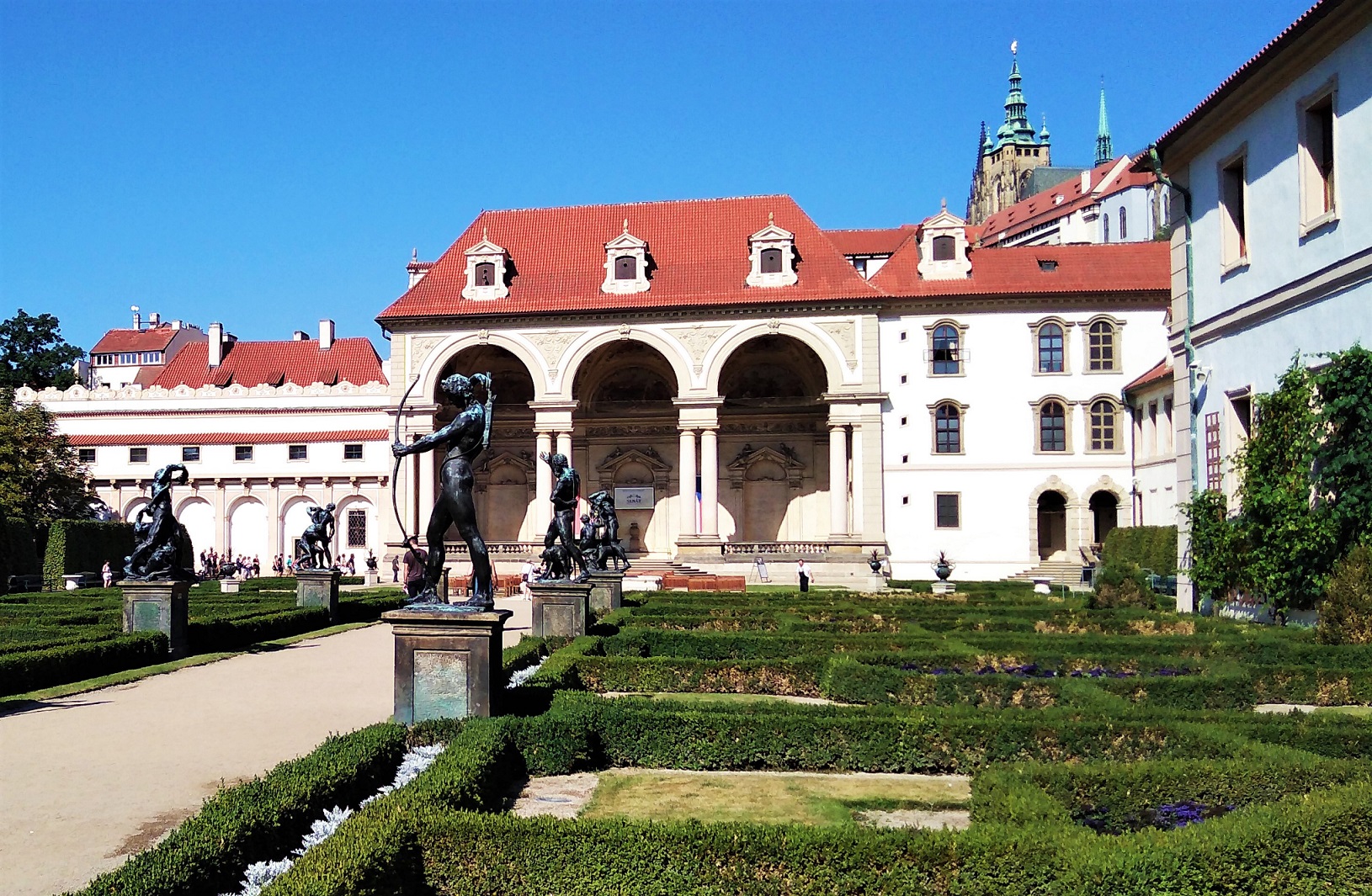
The impressiveness of the Wallenstein Palace can be admired in the summer season from the adjacent Baroque garden, one of the exits of which is by Malostranská metro station.
Josef Mysliveček, a native of Prague and a trained miller, became, against all odds, one of the most sought-after and successful composers of Italian classical opera of his time, also excelling as an exceptionally gifted symphonist. In 1763 he left Prague for Venice, and after only three years his first opera Semiramide riconosciuta (Semiramis Recognized) was staged in Bergamo; following the extraordinary success of his opera Il Bellerofonte (The Bellerofontes) he performed in Naples and had a number of other successes throughout Italy. He wrote 26 serious operas, 8 oratorios and a number of diverse instrumental compositions. Mysliveček composed for star singers of his time and his operas were performed on the occasion of royal birthdays, holidays and other important social events. He personally met Austrian Empress Maria Theresa’s three sons and composed several operas for the birthday of her daughter, Queen Maria Caroline of Naples. In addition to Italy, he also established himself in Munich, where his oratorio Isacco, figura del Redentore (Isaac, the model saviour), now judged the absolute pinnacle of his work and previously mistakenly attributed to Mozart, was performed to great acclaim.
By this time Mysliveček was already suffering from health problems and pains, probably caused by syphilis, and passed away in February 1781 in solitude and poverty at the age of only forty-three. He is buried in the Roman church of San Lorenzo in Lucina. After his death, his operas were practically not performed, and Italian serious opera as such went out of fashion. It was only in the twentieth century that they began to be recorded and staged again, and a significant increase in interest in Mysliveček’s work is particularly evident in the last ten years, his music being once again sung by the world’s greatest singers.
